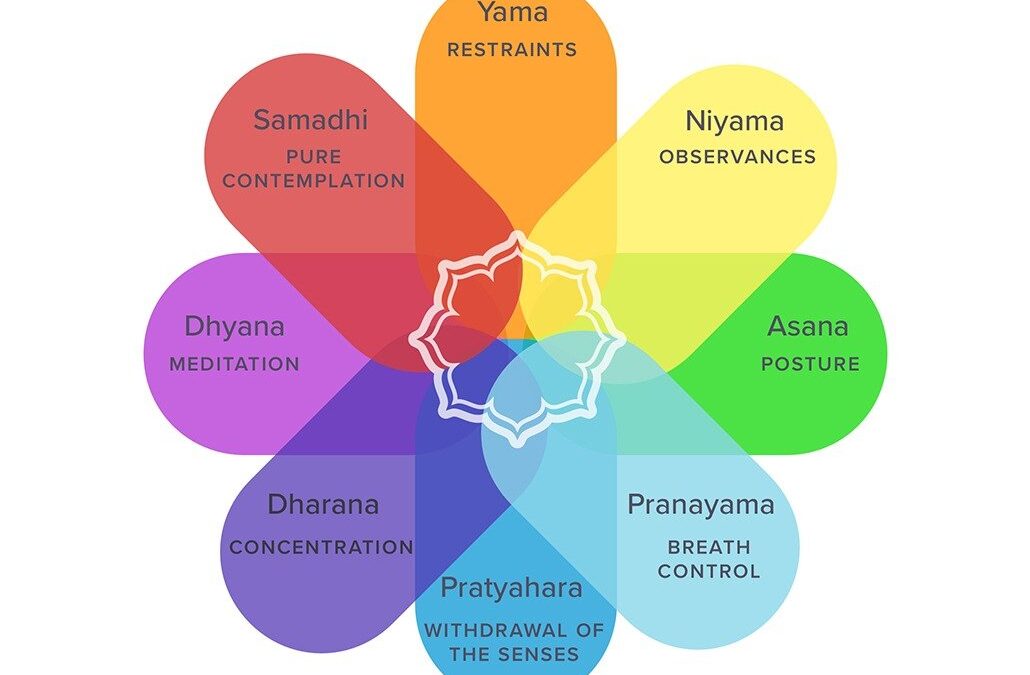There are six core philosophies in Ayurveda: Sankhya (evolving consciousness), Nyaya (logic), Visheshika (physics), Mimamsa (understanding truth), Yoga(unification) and Vedanta (ending of knowledge). These concepts guide the nutritional and spiritual practices of Ayurveda. In this article we will be focusing on the fifth philosophy of Ayurveda, which is Yoga. The word “yoga” originates from the Sanskrit word yuj, which means “to unite”.
Yoga is about so much more than just maintaining physical health. Yoga allows us to create a path for expanding one’s individual consciousness to the Universal Consciousness. Yoga is the union between the lower self with the higher self. When you are able to control and observe your thoughts, you are able to experience enlightenment. The Indian sage Patanjali is credited in the Vedic texts for outlining the eight limbs to attain enlightenment through the Yoga sutras (rules):
1. Yama
(Control)
The first limb of the Yoga sutra has to do with ethics, integrity and practices that relate to our external world. The attitudes we hold towards our environment, and how we conduct ourselves in life are held in this limb. There are five Yamas: Ahimsa(nonviolence), Satya (truthfulness), Asteya (non stealing), Brahmacharya (right use of energy), Aparigraha (non greedy). Though we could be calm in our yoga practice, what does the rest of our life look like on the daily? Are we chronically stressed? Do we harbor toxic resentments? How can we channel our yoga practice into bettering our daily life?
2. Niyama
Ni (inward) + Yama (control)
The second limb is related to self discipline and spiritual practice. Developing your own spiritual routines with meditation (mindful eating, meditation, consistent walks alone) is Niyama in action. Those who wish to be more spiritually in tune will cultivate Niyama. The five Niyamas are: saucha (cleanliness), Santosha(contentment), tapas (discipline/burning desire), svadhyaya (self reflection and spiritual study) and isvarapranidaha (surrender to higher power).
3. Asana
(Seat)
Asana refers to the physical postures of Yoga. Asana means “seat”, which is the seat you take when practicing meditation. We want to be comfortable and stable when sitting, so we do not experience aches and pains, or restlessness that could distract us. This is called sthirasukhasana. Next time when you are practicing yoga, try to hold and maintain a comfortable position to go into meditation. Yoga is not about being performative with advanced poses, it is about connecting your lower and higher self. Please push yourself, but also engage in poses you are comfortable in regularly so you are able to reflect.
4. Pranayama
(Regulation of Breath)
Pranayama refers to breathing techniques. Prana means “life force” or “breath”. It is the energy in life that sustains us, and the universe. Recognizing the relations between your breath, your emotions and the mind is key to understanding the Yoga sutra in Ayurveda. Practicing pranayama every day will change your life over time for the better. Benefits of pranayama include improved digestion, stress prevention and mood stabilization.
5. Pratyahara
Pratya (withdraw) – ahara (take in)
The fifth limb of Yoga has to do with sensory restraint. The practice of pratyaharamakes us able to focus deeply in the present moment, so that we can meditate without succumbing to distractions. This is the limb of objective observance. We can take a look at our habits, reactions, cravings and actions that we partake in without judgement of ourselves. This stage is about introspecting on what is hindering and what is helping our inner growth.
6. Dharana
Dha (holding/maintaining) + Ana (other)
Each stage builds on the previous one, and the practice of Pratyahara makes it so Dharana can occur. To focus, we have to withdraw our senses to be dedicated solely to the point of concentration. Tratak meditation (candle gazing), visualization and focusing on prana (breath) aid is putting Dharana in practice. This stage is about concentration by controlling the senses, not yet meditation.
7. Dhyana
(Meditation)
This is the limb of true meditation. This is the uninterrupted movement and flow of Dharana (concentration). Dharana (concentration) and Dhyana (meditation) are very similar, but the difference is that Dhyana is being vibrantly aware without focus. Dharana is deeply focused on one solid point. In the stage of Dhyana, the mind has been calmed to where there are little to no thoughts. This is truly a challenge to get here but with consistent yoga and meditation practice it is possible to attain Dhyana.
8. Samadhi
Sama (equal/same) + Dhi (to see)
The final stage of the Yoga sutras is Samadhi (bliss). This is the complete integration of all the previous steps to have profound and divine realizations about our oneness with the Universe and experience inner peace. We can experience true ecstasy at this stage, not as a form of escapism, but as a form of divine appreciation of what is around and inside of us. This is not a permanent state of being. Consistently traveling through each of the Yoga sutra stages is important for our continual spiritual, emotional and physical development.
References:
- Textbook of Ayurveda: Fundamental Principles by Vasant Lad, MASc
- EkhartYoga
- YogaJournal
- 8 Limbs Yoga
